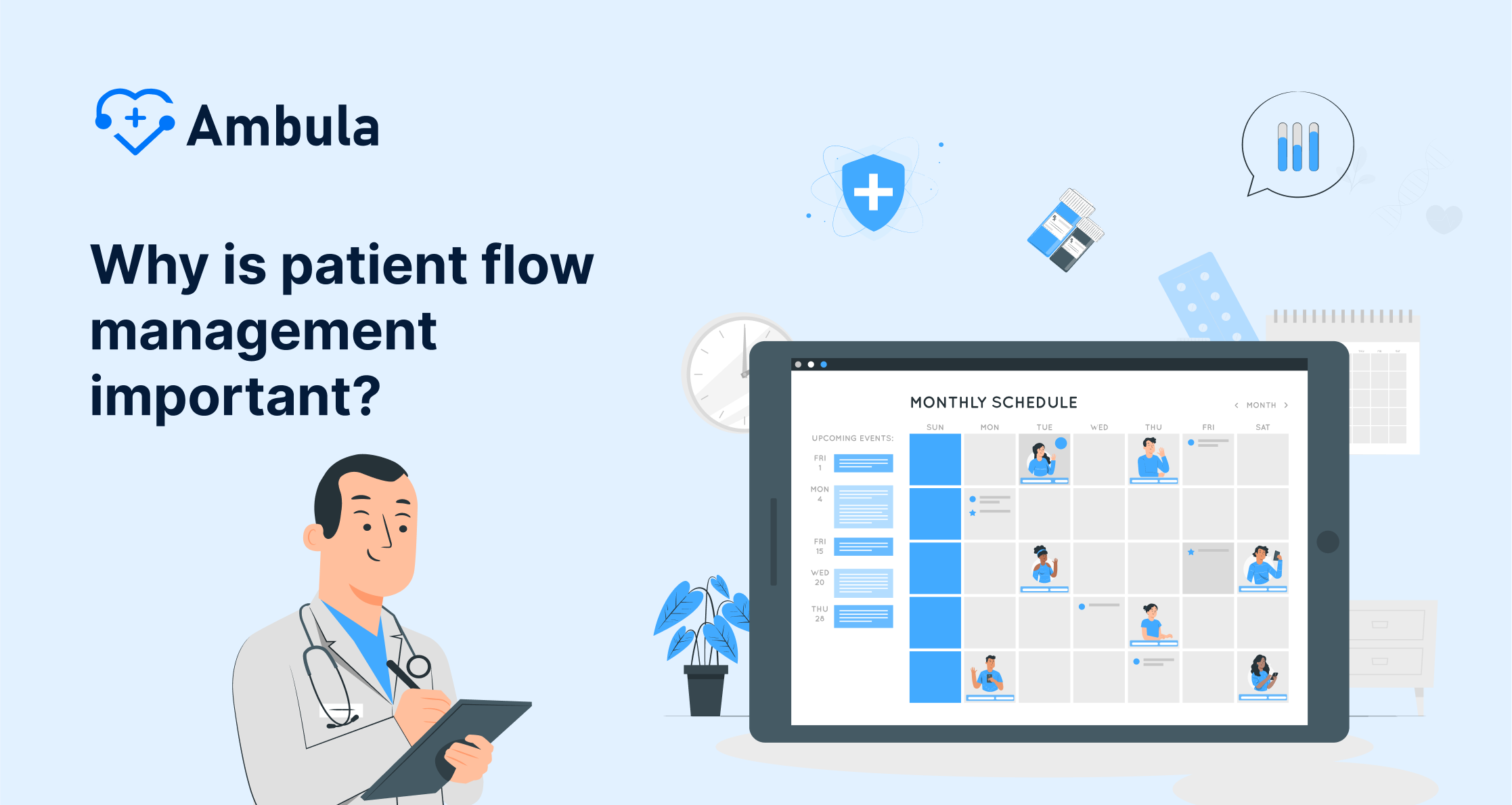What is patient flow?
Patient flow is a pivotal aspect of hospital operations and healthcare management. It’s the process that outlines a patient’s journey through their healthcare experience, from the initial interaction to the final step of their care. This intricate process encompasses various aspects: appointments, admissions, consultations, treatments, and discharge. Efficient patient flow keeps operations smooth, optimizes resources, maintains staff productivity, and, most vitally, ensures patient satisfaction. This article dives deep into the importance of patient flow, its impact, the challenges, and how technological advancements are bridging these gaps in healthcare today.
Understanding the Patient’s Journey
You’re undoubtedly well aware that effective patient flow plays a crucial role in healthcare delivery. Its importance can’t be overstated, as it directly impacts two pivotal points: patient satisfaction and the overall improvement of healthcare quality.
So, how does patient flow resonate with patient satisfaction? Well, put yourself in your patient’s shoes. Imagine You’ve arrived for your appointment, yet you find yourself spending more time languishing in waiting rooms or getting bounced from one department to another. Frustrating, right? A smooth, well-organised patient flow reduces waiting times and ensures a seamless transition through various stages of the diagnosis and treatment procedure. This greatly enhances patient satisfaction. According to a study by the National Institutes of Health, improved patient flow has shown a direct connection with increased patient satisfaction scores.
Next, let’s connect the dots between patient flow and improving healthcare quality. Without a doubt, efficient patient flow facilitates better utilisation of resources, minimises delays, and reduces the chance of clinical errors—all significant contributors to healthcare quality. It ensures that the right patient gets the right care at the right place and time. A study published in the Journal of Hospital Medicine found that poor patient flow can cause overcrowded emergency departments, operating room delays, and increased length of hospital stays—aspects detrimental to healthcare quality.
Further, well-designed patient flow processes can mitigate healthcare workers’ burnout by reducing their workloads, enabling them to deliver more focused and efficient care. In a survey conducted by the Mayo Clinic, it was observed that improved patient flow positively impacts physician satisfaction and reduces stress levels, thereby enhancing the quality of healthcare delivery.
To encapsulate it, you, as healthcare professionals, are responsible for ensuring optimal patient flow. It’s not just about meeting targets but also enhancing the patient experience and delivering high-quality healthcare services. With these perspective points, enhancing patient flow should sit high on our priority list with the broader aim of pushing the boundaries of healthcare excellence.
Importance of Effective Patient Flow
Effective patient flow stands at the epicentre of quality healthcare. To all healthcare professionals, pause and reflect: isn’t the patient journey so much more than just moving from point A to B in a healthcare facility?
Let’s talk about patient satisfaction for a moment. Patient welfare is a factor close to your heart. Remember, this revolves not only around the success of medical procedures but also the overall patient experience from admission to discharge. A study in the British Medical Journal found a direct correlation between improved patient flow and heightened patient satisfaction levels. Simply put, a streamlined patient journey means less waiting and more comprehensive, timely care. This invariably results in happier, more satisfied patients.
Now, healthcare quality. It’s what you’ve devoted your lives to. Guess where the effective patient flow figures are here? Right at the heart of it. A study published in the Annals of Emergency Medicine links efficient patient flow to thoroughly utilizing resources and a redoubled effort to minimize errors. The message is clear: good patient flow equals better healthcare quality. It assures each patient gets precise care at the ideal time and place.
Let’s also not ignore the positive impact of adept patient flow on healthcare staff. A smoother flow process systematically reduces overload and stress among healthcare workers. A report by the Physician Foundation concludes that a well-coordinated patient journey spares unnecessary strain on healthcare professionals, thus boosting overall productivity and job satisfaction.
Dr. Amy Compton-Phillips, Executive Vice President and Chief Clinical Officer at Providence St. Joseph Health, emphasizes the importance of collaboration among healthcare providers and facilities to optimize patient flow. She notes that sharing best practices and coordinating care transitions can help reduce bottlenecks and improve patient outcomes across the continuum of care .
Why is patient flow management important?
One of the key reasons why patient flow management is crucial is that it fosters efficiency. It helps avoid overcrowded waiting rooms and lengthy delays, as the resources are properly allocated based on the urgency and nature of care required. This in turn improves the patient’s overall experience and satisfaction, which can indirectly impact the patient’s recovery and well-being. Conversely, inefficient patient flow can lead to unnecessary delays and an increased risk of healthcare complications.
Right patient, low management Reduced operational costs By optimising resource allocation and minimising delays, effective patient flow management can lead to significant cost savings for healthcare systems. A study found that reducing the ED length of stay by one hour can save a hospital $484 per patient.
Bonus stats:
- The global patient flow management market is expected to reach $6.76 billion by 2027, indicating the growing recognition of its importance.
- A study found that 80% of healthcare executives believe patient flow management is essential for improving patient satisfaction and operational efficiency.
Factors Affecting Patient Flow
Patient flow is the movement of patients through a healthcare system, from the point of entry to the point of discharge. It is a complex process that is affected by a variety of factors, including:
-
Patient demand: The number of patients seeking care at a given time can have a significant impact on patient flow. If there is more demand for care than capacity to provide it, it can lead to longer wait times and overcrowding. According to a 2022 report by the Commonwealth Fund, the average wait time for a primary care appointment in the United States is 24 days.
-
Staffing levels: Adequate staffing is essential for ensuring smooth patient flow. If there are not enough staff members available, it can lead to bottlenecks and delays in care. A 2023 study published in “Health Affairs” found that hospitals with higher staffing levels had shorter wait times for emergency department patients.
-
Resource availability: The availability of resources, such as beds, equipment, and supplies, can also impact patient flow. If there are not enough resources available, it can delay patient care and lead to overcrowding. A 2022 report by the American Hospital Association found that 92% of hospitals in the United States are experiencing staffing shortages, contributing to overcrowding and longer wait times.
-
Process inefficiencies: Inefficient processes can also contribute to patient flow problems. For example, if scheduling appointments is inefficient, it can lead to longer wait times for patients. A 2021 study published in the journal “Patient Experience” found that 60% of patients reported experiencing delays in their care due to inefficient processes.
-
Communication challenges: Poor communication between clinicians, departments, and patients can also lead to delays in care and disruptions to patient flow. A 2022 survey by the American College of Healthcare Executives found that 75% of healthcare leaders reported that communication challenges are a major barrier to improving patient flow.
What You Can Do to Improve Patient Flow
As a healthcare professional or physician, you can play a vital role in improving patient flow by:
- Educate yourself about the factors that affect patient flow. This includes understanding patient demand, staffing levels, resource availability, process inefficiencies, and communication challenges.
- You are identifying and addressing areas for improvement in your practice. Once you know the factors impacting patient flow in your practice, you can start to identify and address areas for improvement. For example, if you notice long patient wait times in your office, you can work with your staff to identify and implement solutions to reduce wait times.
- We are collaborating with other stakeholders. Improving patient flow requires the collaboration of all stakeholders, including clinicians, administrators, and support staff. Work with your colleagues to identify and implement solutions to improve patient flow for everyone involved.
Challenges in Patient Flow
Patient flow is a complex process that can be challenging, even for the most experienced healthcare professionals. Some of the most common challenges to patient flow include the following:
- Long wait times: Patients often must wait a long time to see a clinician, receive a test, or be admitted to a hospital bed. This can be frustrating for patients and can lead to decreased satisfaction with care. According to a 2022 survey by the Press Ganey healthcare consulting firm, 63% of patients reported waiting more than 30 minutes to see a doctor during their last appointment.
- Overcrowding: Overcrowding is a common problem in hospitals and other healthcare facilities, especially during peak times. Overcrowding can lead to longer wait times, delays in care, and an increased risk of infection. A 2022 report by the American Hospital Association found that 92% of hospitals in the United States are experiencing overcrowding due to staffing shortages.
- Bottlenecks: Bottlenecks occur when there is a backlog of patients waiting for a particular service or resource. Various factors, such as limited equipment, staff availability, or bed capacity, can cause bottlenecks. A 2021 study published in the journal “Patient Experience” found that bottlenecks were the most common cause of delays in patient care.
- Communication challenges: Poor communication between clinicians, departments, and patients can lead to delays in care and disruptions to patient flow. For example, if a clinician does not have access to a patient’s medical records, it can delay the patient’s care. A 2022 survey by the American College of Healthcare Executives found that 75% of healthcare leaders reported that communication challenges are a major barrier to improving patient flow.
Technological Advancements Impacting Patient Flow
AI, the frontline of technology, is revolutionising patient flow management. This technology can predict patient influx, ease your staff scheduling process, and quicken patient processing with automated administrative tasks. According to a Harvard Business Review study, AI brings about a whopping 50% improvement in patient scheduling, one of the big wins in managing patient flow effectively.
Telemedicine’s Role in Streamlined Patient Flow
Pushing the boundaries of conventional healthcare is telemedicine. It enables patients to receive necessary care without visiting health facilities, reducing on-site patient volume. In a study by the Journal of Telemedicine and Telecare, teleconsultation efficiently managed 61% of the patients who would typically seek ER assistance. This ensures in-person hospital care is safe for critical cases, optimising patient flow and the judicious use of resources.
The Impact of a Real-Time Locating System (RTLS) on Patient Flow
Then, you have the Real-Time Locating System (RTLS), a digital ace in the hole for managing patient flow. As per an International Journal of Health Geographics report, RTLS can significantly truncate patient wait times and improve room utilization. Thus, it paves the way for improved patient flow by enabling real-time monitoring of patient movement and equipment location.
In summary, harnessing the potential of these technological advancements, such as AI, telemedicine, and RTLS, can lead to a significant streamline in the patient journey, ensuring optimal healthcare delivery.
Leveraging Patient Flow Software for Elevated Healthcare Management
The integration of patient flow software in healthcare operations serves as a transformative leap towards efficient patient flow management. This forward-thinking technology streamlines complex processes, establishing a refined pathway from patient check-in to discharge, while also enhancing resource utilization.
This software plays an integral part in lessening the burden of manual processes. Automated scheduling of appointments, real-time tracking of patient movement, and efficient resource management are key attributes that minimize human-induced errors, subsequently leading to more efficient operations.
Beyond process automation, patient flow software serves as an insightful tool for strategic decisions. It provides real-time analytics which can reveal bottlenecks within the healthcare workflow, keep track of performance measures, and predict upcoming patient demands. These insights drive more precise and effective decision making for healthcare planning and resource allocation.
Strategies to improve patient flow
Reducing wait times
Long wait times are a common complaint among patients and can lead to decreased satisfaction with care. There are several strategies that healthcare organisations and healthcare professionals can implement to reduce wait times, including:
- Using central scheduling systems: Central scheduling systems can help streamline the appointment scheduling process and ensure that patients are scheduled for appointments with the right clinicians at the right times.
- Cross-training staff: Cross-training staff can help reduce bottlenecks and improve flexibility. For example, cross-trained staff can be used to triage patients, provide basic services, or cover for absent staff members.
- Investing in new technologies: New technologies, such as electronic health records (EHRs) and patient portals, can help to improve efficiency and reduce wait times. For example, EHRs can help clinicians access patient information quickly and easily, and patient portals can allow patients to schedule appointments, request refills, and communicate with their providers online.
- Improving communication between staff and patients: Clear and concise communication between staff and patients can help reduce delays in care and disruptions to patient flow. For example, staff should communicate with patients about expected wait times and provide regular updates on their status.
Proper Staffing
Adequate staffing is essential for ensuring smooth patient flow. Healthcare organisations should carefully assess their staffing needs and ensure that there are enough staff members available to meet patient demand. Healthcare professionals should also be aware of the factors that can impact staffing levels, such as vacations, sick days, and turnover.
Here are some tips for ensuring proper staffing:
- Use the data to forecast patient demand. This information can be used to staff appropriately and avoid staffing shortages.
- Cross-train staff. This can help to reduce bottlenecks and improve flexibility.
- Offer competitive salaries and benefits. This can help attract and retain qualified staff members.
- Create a positive work environment. This can help to improve staff morale and productivity.
Other Strategies
In addition to reducing wait times and ensuring proper staffing, there are a number of other strategies that healthcare organisations and healthcare professionals can implement to improve patient flow, including:
- Improving process inefficiencies: Healthcare organisations should identify and address process inefficiencies that can contribute to delays in care. For example, they may streamline the patient registration process or implement new procedures for handling laboratory results.
- Empowering patients to take ownership of their care: Healthcare organisations can empower patients to take ownership of their care by providing them with information about their care and encouraging them to ask questions. For example, they can provide patients with educational materials about their condition or treatment plan.
By implementing these strategies, healthcare organisations and healthcare professionals can improve patient flow and provide better patient care.
As we look forward, numerous advances on the horizon promise to revolutionise patient flow management. From predictive analytics to more integrated telemedicine services, the landscape of patient flow is poised for dazzling change.
Predictive analytics will play a crucial role in shaping the future of patient flow. By analysing patient data, healthcare facilities can anticipate patient influxes, schedule staff optimally, and effectively manage resources. A study by Health Affairs highlights that predictive analytics can decrease patient wait times by up to 30%, showcasing the potential to transform patient flow across healthcare systems.
The role of digital health tools is expected to expand greatly. Technologies like AI and Real-Time Locating Systems (RTLS) aren’t mere fads. Their incorporation into healthcare practices is set to become more widespread, further optimising patient flow. According to Markets and Markets, the global RTLS market is projected to reach 3.9 billion by 2025, attesting to its increasing adoption in health facilities.









